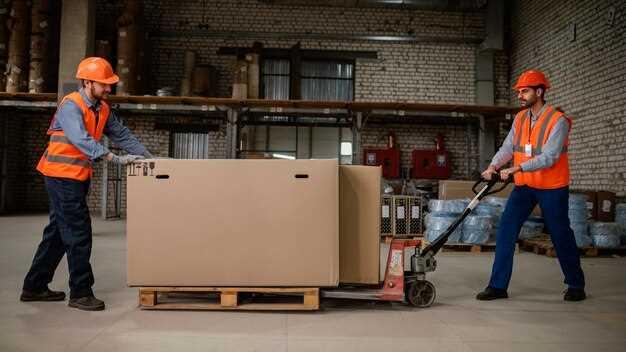In logistics environments, set pick stations at 90–110 cm and use powered carts to keep loads within a 40 cm reach zone. This posture-friendly layout reduces back and shoulder strain and improves accuracy when handling items and products during the order pick. An adjustable setup is advisable for both male and female workers and fits varying item sizes.
Adopt flow racks and personal lifting devices so teams can distribute weight: keep the load close to the torso, bend at the knees, and avoid twisting while moving heavy material. For single-item loads, aim for a maximum unassisted lift near 25 kg; use two-person lifts or mechanical assists for heavier items to reduce risk of injury and to protect joints. Use such techniques consistently to stay safe.
To reduce disorders and fatigue, institute a technique-driven routine: pause every 60–90 minutes, perform short mobility moves, and rotate tasks between picking, packing, and staging. Use such rotations to balance muscle groups and maintain steady throughput.
For daily practice, choose equipment that matches items и products you handle. For bulky loads, use powered pallet jacks or hoists; for delicate items, employ padded grippers to protect the material. A technique-driven approach pairs robotics with human oversight to improve safety and speed.
The process involves data-driven decisions: track injury rates, disorders, and downtime; compare before and after ergonomic changes; aim for at least a 15–25% drop in reported discomfort after six months. Use a simple dashboard to monitor pick accuracy and average order cycle time; this логистика data supports lead teams in prioritizing facility updates.
Invest in инновация that can offer measurable gains: pilot robotics in one zone, measure impact on item flow, and scale what works. A lead indicator is the reduction in manual lifts; a suitable plan adapts shelving height and aisle width to real workflows. By combining ergonomic training with smart tools, you boost safety and throughput while reducing injury.
Warehouse Ergonomics: Practical Tips for Safer, More Productive Warehouses

First, redesign picking zones to keep items with high turnover within arm’s reach, at waist-to-chest height, using adjustable shelves and a lightweight cart system. This change reduces bending and reaching, speeds up tasks, and helps the collaborative team perform with less fatigue, the safety lead said. Over time, the gains accumulate in daily work.
mecalux modular racks support this layout, enabling clear, place-based organization. Group items by activity and case size; assign a dedicated place for each category to reduce search time and improve accuracy. This approach might require upfront investment, but the gains in safety and output pay back.
To extend these gains, standardize processes for receiving, put-away, picking, packing, and staging. Use a simple technique like color-coded zones and place msds at the point of use so workers can quickly reference hazards.
- Cart-based workflows minimize over-walking: keep replenishment routes separate from order-picking paths to reduce physical load and speed transitions.
- Collaborative team lifts for heavy items over a defined threshold, with proper training on safe posture, preventing back injuries significantly.
- Powered equipment such as pallet jacks and conveyors help, reducing twisting and heavy lifting; pair with automated racks when possible to sustain steady throughput.
- Robotic aids can handle repetitive, high-volume tasks, freeing teammates to perform more activities and maintain accuracy.
- Sophisticated route analytics and sensing can forecast workload and suggest optimal item placement, preventing congestion and smoothing flows.
- Refined techniques for manual handling include breaking large loads into smaller ones, using ergonomic grips, and keeping weights close to the body to reduce strain.
- Placement planning and zone mapping make tasks more predictable and cut travel time during shifts.
- Safety and training: maintain up-to-date msds, provide frequent refreshers, and measure task times and injury indicators to guide adjustments.
In a factory case, implementing these measures reduced fatigue and improved throughput. Innovations in collaborative robotic systems and AMRs continue to lead to better safety, better throughput, and higher accuracy.
10 Practical Tips to Improve Safety in the Warehouse

Start each shift with a 5-minute risk check and floor walk to identify immediate hazards, log concerns, and assign owners.
Optimizing handling with mechanical aids move heavy loads safely, reduce physical strain, and lower incidents; even modest gains can translate into a billion-dollar impact for large networks.
Offer tailored training to train teams in ladder safety and fall prevention.
Install engineering controls where risk is high; apply anti-slip flooring, safe pallet racks, and clearly marked pedestrian zones to separate people from equipment.
Create a rapid incident-reporting process and log the источник of every incident to inform targeted improvements.
Adapt storage layouts to minimize reaching and twisting; place high-frequency items at chest height and use ergonomic handling systems, including parsa.
Containing clutter improves visibility and reduces trips; keep aisles clear, mark pedestrian lanes, and verify that exit routes remain accessible.
Provide ladder safety training and regular inspections; retire damaged ladders, choose the right ladder for the task, and maintain three-point contact.
Move toward a seamless safety program by standardizing procedures, which helps teams stay consistent, using concise checklists, and offering quick refresher drills.
Track results, review high-risk areas quarterly, adapt controls to reduce incidents, and share learnings to strengthen overall safety culture.
Optimize Rack Setup and Picking Zones to Minimize Reach and Strain
Place the most frequently picked items in the mid-height zone (40–48 inches from the floor) to reduce overhead reach and shoulder strain, cutting fatigue and boosting pick rates. Use adjustable shelves so this zone stays constant as product mix shifts, and ensure high-demand SKUs stay within a single-move reach. Choose this configuration to create straight paths from picks to conveyors and the packing area, improving flow across workspaces in factory-style operations similar to amazon fulfillment. This layout offers ergonomic solutions for repeated tasks.
Develop zone-based layouts with clearly marked paths. Keep the main walking lane between 5 and 7 meters and align racks to minimize turns, enabling movements that flow along a single route toward the conveyors. Assign one operator lead to monitor zone performance and adjust layouts monthly based on data. Ensure every item has an accessible msds and is paired with simple cleaning procedures to maintain safe, clean aisles. Ensuring consistent movements across shifts requires clear signage and defined paths.
Limit high-reach tasks: store bulkier or less frequent items in the upper zone (60–84 inches) or rely on automation with anthropomorphic robot arms to handle those items. Minimize ladder use, and require a safety device or two-person spot when ladder access is unavoidable. Track the number of required steps per pick; use this metric to rebalance zones and reduce strain during working shifts. Provide ongoing training for operators to optimize movements and avoid unnecessary twisting.
Monitoring and adjustment: collect data on pick frequency, path length, and perceived exertion. Use dashboards to display the number of steps, zone accuracy, and overall strain reductions. Iterate layouts based on results, maintaining a clean flow from receiving, through conveyors, to packing, so cleaning routines stay in sync with operations.
| Zone | Height Range (in) | Typical Items | Pick Frequency | Рекомендуемые действия | Tools/Equipment |
|---|---|---|---|---|---|
| Low Zone | 0–40 | Small parts, fast-moving SKUs | Высокий | Keep in front; use pull-out shelves; limit bending | Bins, adjustable shelves |
| Mid Zone | 40–60 | Medium-size items, frequent replenishment | Medium | Ensure straight path to conveyors; use mobile trolleys | Adjustable racks, bins, dividers |
| High Zone | 60–84 | Bulky or occasional picks | Низкий | Leverage automation or safe ladder access; minimize manual reach | Anthropomorphic robots, conveyors, lift aids |
| Overhead | >84 | Rare items, bulky inventory | Very low | Automation only; plan for crane or robotic handling | Conveyors, cranes |
Master Safe Lifting and Handling Techniques for Daily Tasks
Lift with your legs, keep the load close to your center of gravity, and maintain a neutral spine to support safe postures during daily tasks. For the highest safety margin, plan every lift in advance and keep the path clear to avoid twisting or sudden movements. Ensure you distribute effort evenly to reduce associated strains.
To directly address common daily tasks, place the product at waist height using adjustable workstations and secure footing. For items stored higher, use a ladder only when necessary, with three points of contact and a spotter; never carry while climbing. Use trolleys or powered equipment to move heavy items; avoid manual lifting for loads over 25 kg or when the route includes stairs or slick floors.
In the picking workflow, combine human and robot capabilities: robots handle heavy, repetitive loads with robotics and powered devices, while human staff perform product picking at waist level. This collaboration reduces risky lifts and increases efficiency. Use anthropomorphic guidelines to train new staff on postures and body positioning, such as keeping the load close and avoiding twist when turning.
Real-time feedback and software can flag risky lifts. Use parsa software integrated with facility sensors to alert managers and adjust workflows immediately. Such systems help ensure high safety standards, provide managers with data about risk exposure, and support ongoing training improvements for operators and their teams.
Keep the workflow well-documented and review experience data from picking tasks with managers on a quarterly basis. They should highlight high-risk patterns and trigger small, repeatable changes in tasks, such as adjusting where items are placed, updating ladder usage protocols, or reconfiguring lines in the facility to reduce distance and twisting during product handling. This approach strengthens overall safety and efficiency in daily operations.
- Assess load, center of gravity, and route before lifting
- Use equipment: powered pallet jacks, hoists, tables, and ladders with proper safety checks
- Rotate tasks to avoid repetitive strain and maintain well-defined postures
- Collaborate with robotics for high-repetition or heavy lifting scenarios
- Rely on software and real-time alerts from parsa to optimize daily routines
Leverage Mechanical Aids: Pallet Jacks, Forklifts, and Conveyors
Start with electric pallet jacks for most palletized loads up to 2,500 kg to cut pushing effort by a half and speed up order pick rates. First, equip each operator with a clearly labeled control panel using large letters and intuitive symbols to reduce misoperation. This approach sets the tone for the first step in a streamlined workflow. This helps streamline workflows from the start.
Train workers on proper motions and stance to prevent injuries. Standard technique: keep your back straight, bend at the knees, and test load balance before moving. Use clear labels on pallets; mark with letters for dimensions, weight, and destination. Map routes to streamline travel between zones and reduce unnecessary walking.
Reserve forklifts for high-demand, high-capacity tasks: loads above 2,500 kg or stacks taller than 8 ft. Ensure operators are certified and refreshed annually; perform daily checks; set internal limits on speeds and loads. Use ai-powered fleet software to optimize routes and speeds; track data to reduce fuel use and wear. When available, Mecalux systems can integrate with warehouse software to coordinate with pallet jacks and conveyors, improving first-pass accuracy. If you have narrow aisles, consider pallet jacks or reach trucks to reduce maneuvering risk. Where aisles are wide, forklifts excel; where space is limited, pallet jacks or reach trucks shine. mecalux-compatible software can link with ai-powered analytics.
Conveyors reduce walking distance and merge handoffs between zones. Choose gravity or powered conveyors with automatic stops and guarding. For packing lines, target speeds of 12-24 ft/min and keep pallet spacing consistent to prevent jams. Connect conveyors to warehouse software to maintain a continuous flow and provide data for operations control. Schedule weekly belt tension checks and monthly roller replacement; use ai-powered diagnostics to anticipate downtime and plan maintenance. Keep the environment safe by controlling moisture and spills; maintain clean, dry floors and apply anti-slip mats in wet areas to minimize slipping risks.
Management should map a risk-reduction plan and track KPIs across equipment types. Keep floors clean and dry; log near-miss events to feed continuous improvement. In a supply environment that handles a billion items annually, a modest upgrade to mechanical aids yields measurable ROI and faster experience for workers and operators. A pilot in one zone, supported by data from pallet jacks, forklifts, and conveyors, can scale quickly. The knowledge gained by workers and operators boosts experience and confidence, not just metrics.
Design Aisles and Workstations for Clear Movement and Access
Recommendation: set aisles to 1.5 m for single-direction manual handling and 2.2 m for two-way traffic with pallets. Position racks so items at the fronts align within 8–12 cm of the aisle edge, reducing reach from down positions. Create short, clearly marked cross-aisles every 8–12 m to shorten journeys and improve task times. This layout improves productive picks and adapts to different demand patterns, tailoring the space to the items and workload conditions. A well-planned grid also helps managers track movement data and spot bottlenecks.
Turns and labeling: Turn radii should permit carts to circulate without pause: 700–900 mm for 90-degree corners, with sightlines kept clear. Use floor letters and zone labels (Receiving, Storage, Packing, Shipping) to guide flows; place signage at two-meter height so workers see it while standing. For fast-moving items, position bays within 60–90 cm of the aisle edge to reduce bending and reach, avoiding unnecessary motions and helping to prevent disorders among staff.
Workstations must be height-adjustable and equipped with anti-fatigue mats. Include automatic docking stations for robots and manual pick stations tailored to the task, with robotic arms supported by clear, unobstructed paths. Keep tools at reachable heights and use tool rails to minimize reaching. Such adjustments, in turn, improve comfort, which managers can track via times and fatigue indicators.
Collect data from time-motion studies, worker feedback, and sensor logs to tailor layouts. Compare peak and off-peak periods to refine aisle widths and workstation heights. источник: internal tracking data and worker input. Use these insights to support changes with a structured improvement cycle. Having a documented base helps managers justify upgrades and address concerns from staff.
Labeling and order: maintain consistency with color-coded zones, letters on floor tapes, and numbered bays. Review signage weekly and adjust as processes shift. Ensure that workers can quickly locate items by letters and reach points, reducing mispicks and confusion.
Involve front-line teams in testing changes. Run two-week pilots, measure motions and times, and adjust accordingly. This approach reduces risk of disorders and creates a space that supports tailored, safe work. Must keep safety as a core metric, and managers should solicit input, address concerns, and document results.
Incorporate Breaks, Microbreaks, and Posture Checks to Reduce Fatigue
Implement a breaks protocol: schedule 5-minute microbreaks every 25 minutes of active tasks, and insert a longer 10-minute break after three hours. This regular rhythm reduces sustained muscle tension, supports circulation, and keeps operator focus during moving tasks across the environment, reducing fatigue.
Within the layout, identify three common high-fatigue activities: reaching to high shelves, repetitive grasp-and-release while scanning, and prolonged standing at packing stations. For each, use identifying steps to map movements onto a simple checklist and plan breaks around them; you might perform these checks manually or deploy lightweight robotic aids to assist operator tasks.
During microbreaks, perform 1–2 minutes of movements: neck stretches, shoulder rolls, wrist flexion, ankle circles, and a short walk to a nearby rest area. Keep a timer handy and set prompts onto a nearby screen to signal the break. Stay equipped with comfortable footwear and anti-fatigue mats to support footing.
Posture checks deploy a simple three-step routine at shift start and after breaks: ensure a neutral spine, relaxed shoulders, wrists in line with forearms, and the screen at eye level. The operator can run quick checks, identifying signs of slumping and adjusting height or stance as needed.
Environment and layout considerations: arrange stations to minimize long reaches, keep frequently used items within reach, rotate tasks to balance strain, and choose adjustable chairs or sit-stand desks where feasible. This approach can offer clear guidance for teams and reduces fatigue across common tasks; ensure msds guidance is visible for those handling chemicals.
Measurement and accountability: adopt a simple plan to track fatigue with three metrics–self-reported discomfort after shifts, counts of posture-check corrections, and short-term task flow. Benchmark within 60 days and compare with baseline. Research by banerjee supports breaks and microbreaks as a way to reduce fatigue and sustain performance.

 Warehouse Ergonomics – Practical Tips for Safer, More Efficient Warehouses">
Warehouse Ergonomics – Practical Tips for Safer, More Efficient Warehouses">
